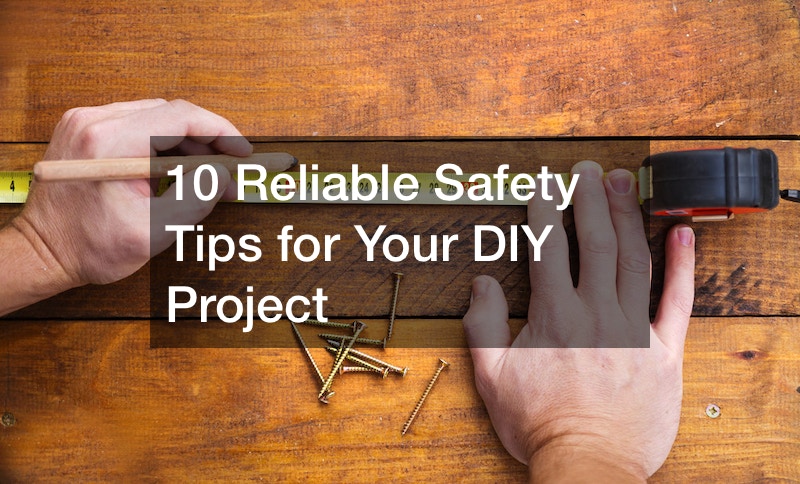
Working on your house is a rewarding and exciting undertaking. However, you always want to make safety a top priority. No matter how many DIY projects you’ve worked on over the years, you can’t underestimate taking precautions for your safety. Consider these tips before starting your next project.
1. Check List

Safety is paramount when undertaking a DIY project, especially a significant AC installation. To reduce any safety risks and keep your project focused and on target, a full checklist can provide reliable safety tips. A checklist helps you prepare for your next project. It would be best if you had a thorough understanding of the installation before beginning. Once you understand all the steps, you can collect all the materials and tools.
It’s critical to be aware of the power sources in the area where you work. You must disconnect all power sources to the workspace so you can avoid electrical accidents. You always want to have proper attire to protect yourself during any project you undertake.
Comfortable clothing, safety goggles, and gloves should be among the gear you should have available. When your project involves climbing off the ground, you are going to need a ladder. The scope of your project may require you to need multiple ladders. To remain safe, you need a stable and sturdy ladder. It’s critical that there are three points of contact when you climb the ladder.
All projects require tools. It’s essential that you use the proper tools for the project and that you use high-quality tools. When you use low-quality tools, you are setting yourself up for accidents or low-quality work. Always make sure you’re working with tools that work properly and are free of damage.
2. Personal Protective Equipment
Personal protective equipment is on the safety checklist you created in the first step. When you have appropriate equipment, it provides you with reliable safety every time. When your goal is to safeguard yourself and your work, there are different types of equipment available for use.
Some equipment you should have on hand before starting any project include safety goggles. Your eyes are protected from dust, debris, and chemicals. They are critical when you are mixing and applying chemicals or hazardous materials. You should have a respirator or mask when taking on an asphalt sealcoating project. This equipment protects your respiratory system from inhaling harmful fumes and particles. A proper respirator or mask allows you to breathe clean air while working.
Chemical-resistant gloves are necessary to protect your hands from potential skin irritation or contact with hazardous materials. Nitrile gloves are often a suitable choice. When getting dressed for your project, opt for long-sleeved shirts and pants to cover your skin. This helps to minimize direct contact with dangerous materials. It would be best if you considered investing in boots with traction. Sturdy boots with good traction help prevent slipping on wet or uneven surfaces while applying materials.
3. Obstacles
When you are concerned about the reliable safety of you, your workers, and your home when taking on a DIY project, you should also know about what obstacles may stand in your way. A lack of knowledge and experience can be a major challenges. DIY projects often involve complex procedures, especially for a project that includes a fireplace installation. Hence, a complete understanding of safety protocols and techniques are essential. When you don’t have this knowledge, the risk of accidents increases.
Another considerable obstacle is the lack of appropriate and suitable personal protective equipment (PPE). When you use improper equipment, you are compromising your safety. When you don’t have access to specialized tools and equipment that are required for the installation, it stands in the way of safe execution.
Having enough time to complete the project is an ideal way to keep yourself safe. When you rush planning or put constraints on yourself, you are creating obstacles. When trying to rush through a project, the risk of an accident increases. Many DIY projects demand adherence to local building codes and regulations. Failure to comply with these standards can lead to safety hazards and legal issues.
4. Helping Hands

When prioritizing reliable safety tips for a DIY project, it’s crucial to recognize when you need a little extra help. Experienced professionals provide insights right on time when the circumstances present themselves. A great example is work injury attorneys. They can offer invaluable guidance on legal matters related to safety compliance and liability. You may also benefit from consultations with experienced contractors or tradespeople. They can give insight into the best practices across specific industries, including specific safety protocols your project may need.
A second pair of eyes is always beneficial during critical steps. A family member or friend keeps you safe by identifying potential risks and offer immediate assistance in case of emergencies. An assistant is always nice to have when your project includes heavy lifting, intricate tasks, or unfamiliar equipment. An extra body can reduce the risk of accidents and improve overall project execution. When taking on a DIY project, you must maintain an awareness of your safety needs. It’s imperative that you know when you should ask for help.
5. Alertness
One of the most reliable safety tips you can depend on is to stay alert. Hardwood projects require a special amount of alert activity. To be alert, you must be fully present and attentive during every step and phase of the project. Potential hazards are promptly identified and addressed. It’s critical to remain vigilant to allow for proper and precise cutting and secure fastening. When working with any type of material, it’s essential that you use the proper tools. Any time you don’t pay close attention to the task at hand, it could result in accidents or compromised project quality.
One of the top ways you can remain alert is to maintain a clutter-free and organized workspace. Organization reduces the risk of tripping hazards and ensures a clear path for movement. This reduces the hazards around your work area. You must remain alert anytime you are handling power tools or machinery. This helps you avoid unintended slips, which keeps you safer and promises success. Changes in light or weather can impact your alertness you are while working on the project.
6. Proper Technique
There is nothing that can replace proper technique when thinking about reliable safety tips during a DIY project. Some projects, like designing a pool building, require complex tasks and steps. When your goal is to complete the project successfully, you must stick to proper procedures.
When planning a building, it has many different aspects, from demolition and excavation to preparing the foundation. You also don’t want to overlook electrical and plumbing needs. There are industry guidelines that must be followed while using the proper tools. This allows you to create your vision with precise care. When constructing a building, you want to be sure the building is structurally sound and secure.
When you have poor or faulty construction, it can lead to accidents or hazards that can be long-lasting. Each industry has recommended regulations and methods to help safeguard the project and yourself from risks. When working with heavy equipment and hazardous materials, you must follow proper techniques to reduce injury or poor work. Proper techniques include protective gear, proper tools, and lifting techniques. Collaboration and communication are critical techniques needed between workers to reduce misunderstandings and problems.
7. Occasional Breaks

When it comes to reliable safety tips for any DIY project, you must recognize the need for regular breaks. This is true for all types of projects, especially when working with heavy items like a wholesale brick paver. There’s a desire to complete all projects efficiently and effectively. However, no matter how badly you want to finish your project, you must take breaks to finish the project the best way possible. When you opt to push through and not take breaks, you may have decreased focus and fatigue. These can lead to a compromise of safety.
There are many purposes to taking an occasional break. It allows you to feel physical rejuvenation because you are allowing yourself to rest. Muscle strain and other exertion injuries are reduced. From a mental perspective, when you take a break, it helps you remain focused and clear. Most DIY projects require intense concentration and attention to detail. When you work for prolonged periods without taking any breaks, you may have a lapse in judgment. When this occurs, there is a greater chance of an accident.
8. First Aid
You may not immediately think so, but first aid is critical when considering reliable safety tips for a DIY project. Any task you take on as part of a project may cause injuries or accidents. Tasks such as metal roofing services can be especially taxing and may cause injury. No matter what type of preventative steps you take, accidents can still occur. You may find scrapes, cuts, or more serious injuries because of the sharp tools and edges. Strong knowledge of first aid and required supplies is essential.
It’s imperative that you have proper first aid training to give you the skills you need to provide the necessary care when needed. You should have a basic understanding of bandaging, cleaning wounds, and basic life-saving measures. First aid principles foster proactive measures to prevent accidents and prompt immediate action in case of emergencies. You don’t want to overlook incorporating first aid into your plan. Knowing first aid creates a situation for you to respond effectively to unexpected situations. This knowledge safeguards your well-being and others involved in the project.
9. Proper Equipment
The use of proper equipment is paramount when looking for reliable safety tips for a DIY project. When seeking a fundamental aspect of maintaining a safe work environment, you must use the right tools for the job. With plumbing-related DIY projects, you must use accurate and suitable equipment to prevent accidents and injuries. You are going to need tools like wrenches, pipe cutters, and safety goggles if you are focused on pipe installations or repairs. When you don’t use the proper equipment, it can quickly lead to mishaps or compromised project outcomes.
The proper equipment enhances efficiency and accuracy. Working with the right tools reduces the need for you to make up solutions. Last minute solutions create additional risks. When you don’t need them, there is a reduced likelihood of making mistakes. Mistakes easily lead to leaks, water damage, or other plumbing issues.
You don’t want to forget the use of safety gear. This includes gloves and protective eyewear to shield yourself from potential hazards like chemical exposure or sharp objects. If you choose to ignore these safety tips, it could lead to injuries that might have been preventable. In the event you find yourself in a difficult situation, you should contact a professional plumber so you don’t create a larger problem.
10. Egress

Depending on your DIY project, you want to ensure that you always have a clear and safe exit route. This is also referred to as an egress. Ensuring a readily accessible escape path is crucial as a reliable safety measure and provides an exit strategy in case of emergencies. If your project is related to gutter repair, you want to prepare yourself for any unexpected events. The best way to protect yourself is to have a path for a quick exit. This is essential when you’re working in a small space or up high.
When you’re planning an egress route, it should be free from obstructions and easily navigable. In addition, you want it to be well-lit, clearly marked, and easily reachable at all times during the project. When you have a well-prepared egress, it helps reduce the panic that can occur during emergencies. You can take advantage of the ability to respond quickly. Creating this egress shows that you are prioritizing a commitment to safety.
Nothing is more important than safety. When you opt to take on a DIY project, these tips can help keep you safe. You don’t want to overlook a step at the risk of causing harm or making a mistake during your project.




